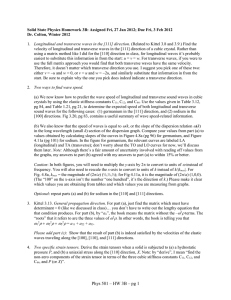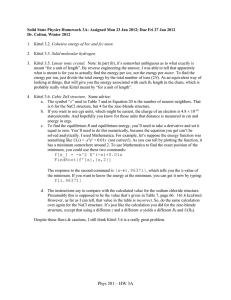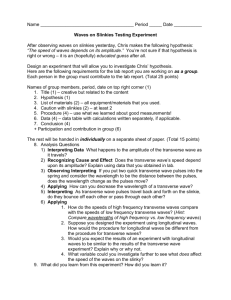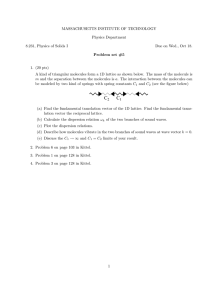Solid State Physics Homework 3: Assigned Friday, Jan 28; Due... Dr. Colton, Winter 2011 Cohesive energy of bcc and fcc neon.
advertisement
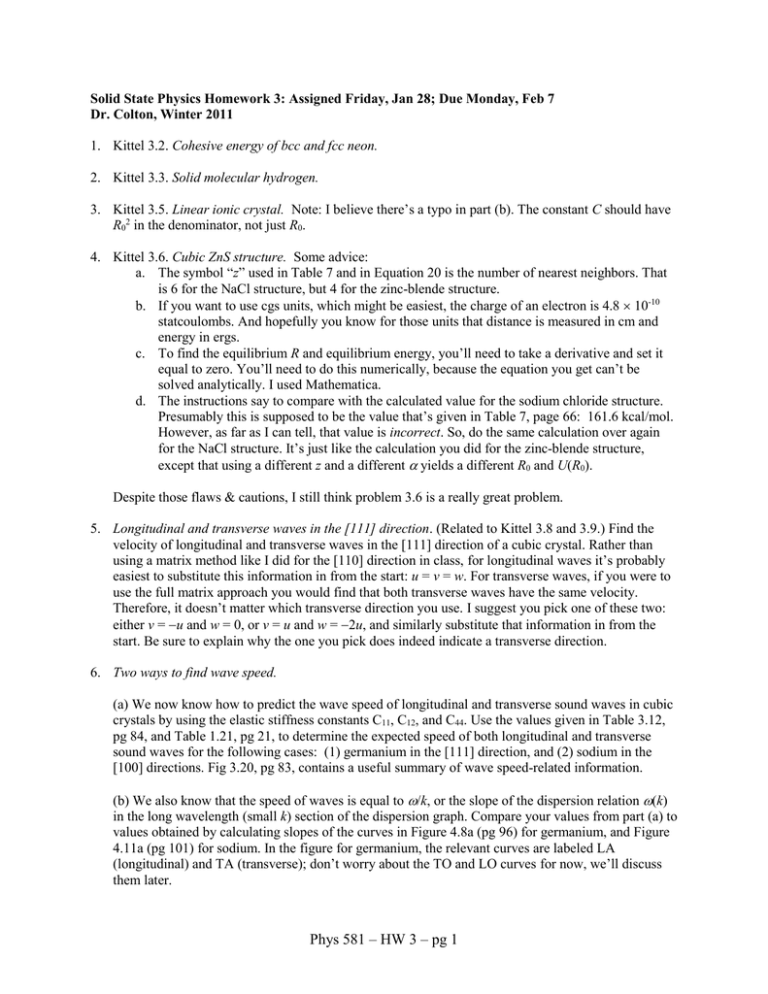
Solid State Physics Homework 3: Assigned Friday, Jan 28; Due Monday, Feb 7 Dr. Colton, Winter 2011 1. Kittel 3.2. Cohesive energy of bcc and fcc neon. 2. Kittel 3.3. Solid molecular hydrogen. 3. Kittel 3.5. Linear ionic crystal. Note: I believe there’s a typo in part (b). The constant C should have R02 in the denominator, not just R0. 4. Kittel 3.6. Cubic ZnS structure. Some advice: a. The symbol “z” used in Table 7 and in Equation 20 is the number of nearest neighbors. That is 6 for the NaCl structure, but 4 for the zinc-blende structure. b. If you want to use cgs units, which might be easiest, the charge of an electron is 4.8 10-10 statcoulombs. And hopefully you know for those units that distance is measured in cm and energy in ergs. c. To find the equilibrium R and equilibrium energy, you’ll need to take a derivative and set it equal to zero. You’ll need to do this numerically, because the equation you get can’t be solved analytically. I used Mathematica. d. The instructions say to compare with the calculated value for the sodium chloride structure. Presumably this is supposed to be the value that’s given in Table 7, page 66: 161.6 kcal/mol. However, as far as I can tell, that value is incorrect. So, do the same calculation over again for the NaCl structure. It’s just like the calculation you did for the zinc-blende structure, except that using a different z and a different yields a different R0 and U(R0). Despite those flaws & cautions, I still think problem 3.6 is a really great problem. 5. Longitudinal and transverse waves in the [111] direction. (Related to Kittel 3.8 and 3.9.) Find the velocity of longitudinal and transverse waves in the [111] direction of a cubic crystal. Rather than using a matrix method like I did for the [110] direction in class, for longitudinal waves it’s probably easiest to substitute this information in from the start: u = v = w. For transverse waves, if you were to use the full matrix approach you would find that both transverse waves have the same velocity. Therefore, it doesn’t matter which transverse direction you use. I suggest you pick one of these two: either v = u and w = 0, or v = u and w = 2u, and similarly substitute that information in from the start. Be sure to explain why the one you pick does indeed indicate a transverse direction. 6. Two ways to find wave speed. (a) We now know how to predict the wave speed of longitudinal and transverse sound waves in cubic crystals by using the elastic stiffness constants C11, C12, and C44. Use the values given in Table 3.12, pg 84, and Table 1.21, pg 21, to determine the expected speed of both longitudinal and transverse sound waves for the following cases: (1) germanium in the [111] direction, and (2) sodium in the [100] directions. Fig 3.20, pg 83, contains a useful summary of wave speed-related information. (b) We also know that the speed of waves is equal to /k, or the slope of the dispersion relation (k) in the long wavelength (small k) section of the dispersion graph. Compare your values from part (a) to values obtained by calculating slopes of the curves in Figure 4.8a (pg 96) for germanium, and Figure 4.11a (pg 101) for sodium. In the figure for germanium, the relevant curves are labeled LA (longitudinal) and TA (transverse); don’t worry about the TO and LO curves for now, we’ll discuss them later. Phys 581 – HW 3 – pg 1 Caution: In both figures, you will need to multiply the y-axis by 2 to convert to units of instead of frequency. You will also need to rescale the x-axis to convert to units of k instead of k/|kmax|. For Fig. 4.8a, kmax = the magnitude of (2/a) (½,½,½); for Fig 4.11a, it is the magnitude of (2/a) (1,0,0). (The “100” on the x-axis isn’t the number “one hundred”, it’s the direction of k.) Please make it clear which values you are obtaining from tables and which values you are measuring from graphs. Optional: repeat parts (a) and (b) for sodium in the [110] and [111] directions. 7. Kittel 3.13. General propagation direction. For part (a), just find the matrix which must have determinant = 0 (like we discussed in class)… you don’t have to write out the lengthy equation that that condition produces. For part (b), by “aii”, the book means the matrix without the –2 terms. The “roots” that it refers to are the three values of 2. In other words, the book is telling you that 222 = a11 + a22 + a33. Please add part (c): Show that the result of part (b) is indeed satisfied by the velocities of the elastic waves traveling along the [100], [110], and [111] directions. 8. Two specific strain tensors. Derive the strain tensors when a solid is subjected to (a) a hydrostatic pressure P, and (b) a uniaxial stress along the [110] direction, X. Note: by “derive”, I mean “find the non-zero components of the strain tensor in terms of the three cubic stiffness constants C11, C12, and C44, and P (or X)”. Hint for (a): “hydrostatic” is like air pressure, where stress is applied in all three dimensions equally, with no torque. The stress tensor in matrix form is: 0 P 0 ij 0 P 0 0 0 P Hint for (b): For a uniaxial stress in the [110] direction, the force is obviously in the [110] direction. The area (that is, the normal to the surface) is also in the [110] direction. There are therefore two force components and two area components to worry about, which give rise to 4 non-zero terms in the stress tensor (matrix form): 1 1 0 ij X 1 1 0 0 0 0 Prove that this matrix is correct before you use it to determine the strain tensor. In both cases I used Mathematica to do symbolic matrix inversion (using the Invert[] command, as in Invert[matrixA]) and multiplication (using the “.” command, as in matrixB . vectorC). I also found the Simplify[] command useful for, well, simplifying, and the MatrixForm[] command useful for visualizing the matrix elements. You can do things without Mathematica, of course, possibly using Eqn 51 (pg 80), but I found Mathematica to be easiest. Phys 581 – HW 3 – pg 2
